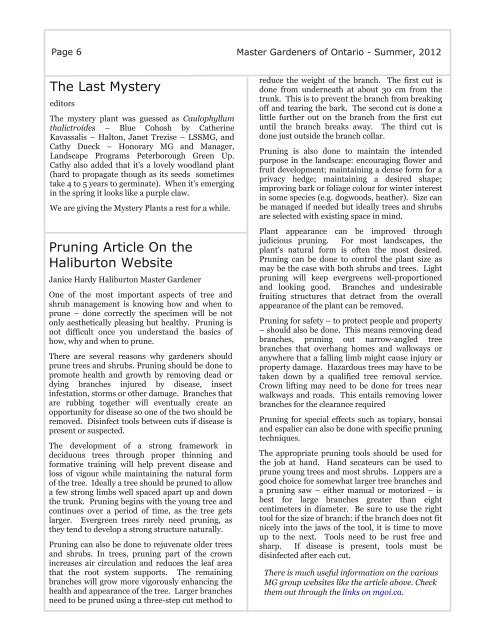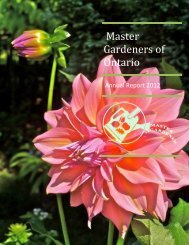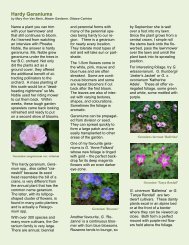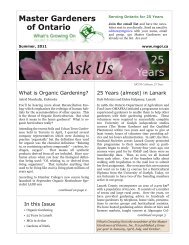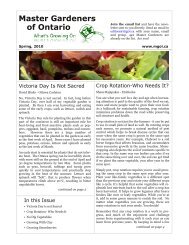Create successful ePaper yourself
Turn your PDF publications into a flip-book with our unique Google optimized e-Paper software.
Page 6<strong>Master</strong> <strong>Gardeners</strong> <strong>of</strong> <strong>Ontario</strong> <strong>Summer</strong>, <strong>2012</strong>The Last MysteryeditorsThe mystery plant was guessed as Caulophyllumthalictroides – Blue Cohosh by CatherineKavassalis – Halton, Janet Trezise – LSSMG, andCathy Dueck – Honorary MG and Manager,Landscape Programs Peterborough Green Up.Cathy also added that it's a lovely woodland plant(hard to propagate though as its seeds sometimestake 4 to 5 years to germinate). When it's emergingin the spring it looks like a purple claw.We are giving the Mystery Plants a rest for a while.Pruning Article On theHaliburton WebsiteJanice Hardy Haliburton <strong>Master</strong> GardenerOne <strong>of</strong> the most important aspects <strong>of</strong> tree andshrub management is knowing how and when toprune – done correctly the specimen will be notonly aesthetically pleasing but healthy. Pruning isnot difficult once you understand the basics <strong>of</strong>how, why and when to prune.There are several reasons why gardeners shouldprune trees and shrubs. Pruning should be done topromote health and growth by removing dead ordying branches injured by disease, insectinfestation, storms or other damage. Branches thatare rubbing together will eventually create anopportunity for disease so one <strong>of</strong> the two should beremoved. Disinfect tools between cuts if disease ispresent or suspected.The development <strong>of</strong> a strong framework indeciduous trees through proper thinning andformative training will help prevent disease andloss <strong>of</strong> vigour while maintaining the natural form<strong>of</strong> the tree. Ideally a tree should be pruned to allowa few strong limbs well spaced apart up and downthe trunk. Pruning begins with the young tree andcontinues over a period <strong>of</strong> time, as the tree getslarger. Evergreen trees rarely need pruning, asthey tend to develop a strong structure naturally.Pruning can also be done to rejuvenate older treesand shrubs. In trees, pruning part <strong>of</strong> the crownincreases air circulation and reduces the leaf areathat the root system supports. The remainingbranches will grow more vigorously enhancing thehealth and appearance <strong>of</strong> the tree. Larger branchesneed to be pruned using a threestep cut method toreduce the weight <strong>of</strong> the branch. The first cut isdone from underneath at about 30 cm from thetrunk. This is to prevent the branch from breaking<strong>of</strong>f and tearing the bark. The second cut is done alittle further out on the branch from the first cutuntil the branch breaks away. The third cut isdone just outside the branch collar.Pruning is also done to maintain the intendedpurpose in the landscape: encouraging flower andfruit development; maintaining a dense form for aprivacy hedge; maintaining a desired shape;improving bark or foliage colour for winter interestin some species (e.g. dogwoods, heather). Size canbe managed if needed but ideally trees and shrubsare selected with existing space in mind.Plant appearance can be improved throughjudicious pruning. For most landscapes, theplant’s natural form is <strong>of</strong>ten the most desired.Pruning can be done to control the plant size asmay be the case with both shrubs and trees. Lightpruning will keep evergreens wellproportionedand looking good. Branches and undesirablefruiting structures that detract from the overallappearance <strong>of</strong> the plant can be removed.Pruning for safety – to protect people and property– should also be done. This means removing deadbranches, pruning out narrowangled treebranches that overhang homes and walkways oranywhere that a falling limb might cause injury orproperty damage. Hazardous trees may have to betaken down by a qualified tree removal service.Crown lifting may need to be done for trees nearwalkways and roads. This entails removing lowerbranches for the clearance requiredPruning for special effects such as topiary, bonsaiand espalier can also be done with specific pruningtechniques.The appropriate pruning tools should be used forthe job at hand. Hand secateurs can be used toprune young trees and most shrubs. Loppers are agood choice for somewhat larger tree branches anda pruning saw – either manual or motorized – isbest for large branches greater than eightcentimeters in diameter. Be sure to use the righttool for the size <strong>of</strong> branch: if the branch does not fitnicely into the jaws <strong>of</strong> the tool, it is time to moveup to the next. Tools need to be rust free andsharp. If disease is present, tools must bedisinfected after each cut.There is much useful information on the variousMG group websites like the article above. Checkthem out through the links on mgoi.ca.


